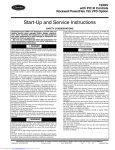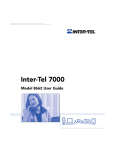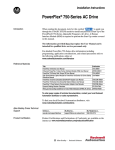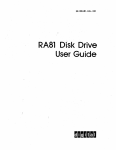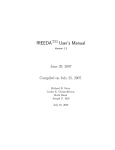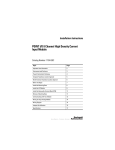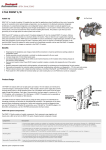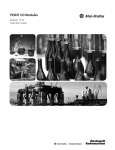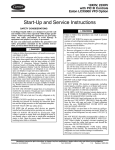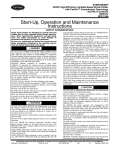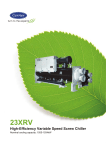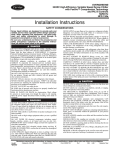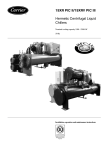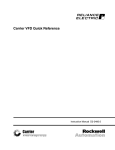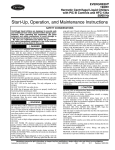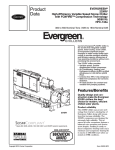Download 19/23-6SS - HVACpartners
Transcript
19XRV, 23XRV with PIC III Controls Rockwell PowerFlex 755 VFD Option Start-Up and Service Instructions SAFETY CONSIDERATIONS Centrifugal and screw compressor liquid chillers are designed to provide safe and reliable service when operated within design specifications. When operating this equipment, use good judgment and safety precautions to avoid damage to equipment and property or injury to personnel. Be sure you understand and follow the procedures and safety precautions contained in the chiller instructions as well as those listed in this guide. DANGER Failure to follow these procedures will result in severe personal injury or death. ONLY QUALIFIED electrical personnel familiar with the construction and operation of this equipment and the hazards involved should install, adjust, operate, or service this equipment. READ AND UNDERSTAND this manual and other applicable manuals in their entirety before proceeding. Failure to observe this precaution could result in severe bodily injury or loss of life. DO NOT install modification kits with power applied to the drive. Disconnect and lock out incoming power before attempting such installation or removal. Failure to observe this precaution could result in severe bodily injury or loss of life. UNUSED WIRES in conduit must be grounded at both ends to avoid a possible shock hazard caused by induced voltages. Also, if a drive sharing a conduit is being serviced or installed; all drives using this conduit should be disabled to eliminate the possible shock hazard from cross-coupled motor leads. Failure to observe these precautions could result in bodily injury. DO NOT VENT refrigerant relief valves within a building. Outlet from rupture disc or relief valve must be vented outdoors in accordance with the latest edition of ANSI/ ASHRAE 15 (American National Standards Institute/ American Society of Heating, Refrigerating, and Air-Conditioning Engineers). The accumulation of refrigerant in an enclosed space can displace oxygen and cause asphyxiation. PROVIDE adequate ventilation in accordance with ANSI/ ASHRAE 15, especially for enclosed and low overhead spaces. Inhalation of high concentrations of vapor is harmful and may cause heart irregularities, unconsciousness, or death. Misuse can be fatal. Vapor is heavier than air and reduces the amount of oxygen available for breathing. Product causes eye and skin irritation. Decomposition products are hazardous. DO NOT USE OXYGEN to purge lines or to pressurize a chiller for any purpose. Oxygen gas reacts violently with oil, grease, and other common substances. (Dangers continued in next column.) DANGER NEVER EXCEED specified test pressures, VERIFY the allowable test pressure by checking the instruction literature and the design pressures on the equipment nameplate. DO NOT USE air for leak testing. Use only refrigerant or dry nitrogen. DO NOT VALVE OFF any safety device. BE SURE that all pressure relief devices are properly installed and functioning before operating any chiller. THERE IS A RISK OF INJURY OR DEATH by electrocution. High voltage may be present on the motor leads even though the motor is not running. Open the power supply disconnect before touching motor leads or terminals. WARNING Failure to follow these procedures may result in personal injury or death. DO NOT USE TORCH to remove any component. System contains oil and refrigerant under pressure. To remove a component, wear protective gloves and goggles and proceed as follows: a. Shut off electrical power to unit. b. Recover refrigerant to relieve all pressure from system using both high-pressure and low pressure ports. c. Traces of vapor should be displaced with nitrogen and the work area should be well ventilated. Refrigerant in contact with an open flame produces toxic gases. d. Cut component connection tubing with tubing cutter and remove component from unit. Use a pan to catch any oil that may come out of the lines and as a gage for how much oil to add to the system. e. Carefully unsweat remaining tubing stubs when necessary. Oil can ignite when exposed to torch flame. DO NOT work on high-voltage equipment unless you are a qualified electrician. DO NOT WORK ON electrical components, including control panels, switches, VFD, or oil heater until you are sure ALL POWER IS OFF and no residual voltage can leak from capacitors or solid-state components. LOCK OPEN AND TAG electrical circuits during servicing. IF WORK IS INTERRUPTED, confirm that all circuits are de-energized before resuming work. AVOID SPILLING liquid refrigerant on skin or getting it into the eyes. USE SAFETY GOGGLES. Wash any spills from the skin with soap and water. If liquid refrigerant enters the eyes, IMMEDIATELY FLUSH EYES with water and consult a physician. (Warnings continued on next page.) Manufacturer reserves the right to discontinue, or change at any time, specifications or designs without notice and without incurring obligations. Catalog No. 04-53190033-01 Printed in U.S.A. Form 19/23-6SS Pg 1 8-15 Replaces: 19/23-4SS WARNING CAUTION DO NOT ATTEMPT TO REMOVE fittings, covers, etc., while chiller is under pressure or while chiller is running. Be sure pressure is at 0 psig (0 kPa) before breaking any refrigerant connection. USE only repair or replacement parts that meet the code requirements of the original equipment. PERIODICALLY INSPECT all valves, fittings, and piping for corrosion, rust, leaks, or damage. DO NOT re-use compressor oil or any oil that has been exposed to the atmosphere. Dispose of oil per local codes and regulations. DO NOT leave refrigerant system open to air any longer than the actual time required to service the equipment. Seal circuits being serviced and charge with dry nitrogen to prevent oil contamination when timely repairs cannot be completed. CAUTION Failure to follow these procedures may result in personal injury or damage to equipment. TO AVOID an electric shock hazard, verify that the voltage on the bus capacitors has discharged completely before servicing. Check the DC bus voltage at the power terminal block by measuring between the +DC and -DC terminals, between the +DC terminal and the chassis, and between the -DC terminal and the chassis. The voltage must be zero for all three measurements. THE USER is responsible to conform with all applicable local, national, and international codes. Failure to observe this precaution could result in damage to, or destruction of, the equipment. THIS DRIVE contains ESD (electrostatic discharge) sensitive parts and assemblies. Static control precautions are required when installing, testing, servicing or repairing this assembly. Component damage may result if ESD control procedures are not followed. For static control procedures, reference Rockwell publication Guarding Against Electrostatic Damage, or any other applicable ESD protection handbook. DO NOT alter the setting of any jumper. Failure to observe this precaution could result in damage to, or destruction of, the equipment. USE OF power correction capacitors on the output of the drive can result in erratic operation of the motor, nuisance tripping, and/or permanent damage to the drive. Remove power correction capacitors before proceeding. Failure to observe this precaution could result in damage to, or destruction of, the equipment. MOST CODES require that upstream branch circuit protection be provided to protect input power wiring. If fuses are chosen as the protection method, refer to the PowerFlex 750 user manual. Failure to observe this precaution could result in damage to, or destruction of, the equipment. DO NOT route signal and control wiring with power wiring in the same conduit. This can cause interference with drive operation. Failure to observe this precaution could result in damage to, or destruction of, the equipment. DISTRIBUTION SYSTEM short circuit capacity shall not exceed the rating of the drive. Failure to observe this precaution could result in damage to, or destruction of, the equipment. DO NOT STEP on refrigerant lines. Broken lines can whip about and release refrigerant, causing personal injury. DO NOT climb over a chiller. Use platform, catwalk, or staging. Follow safe practices when using ladders. USE MECHANICAL EQUIPMENT (crane, hoist, etc.) to lift or move inspection covers or other heavy components. Even if components are light, use mechanical equipment when there is a risk of slipping or losing your balance. BE AWARE that certain automatic start arrangements CAN ENGAGE THE VFD, TOWER FAN, OR PUMPS. Open the disconnect ahead of the VFD, tower fans, or pumps. (Cautions continued in next column.) CONTENTS Page SAFETY CONSIDERATIONS . . . . . . . . . . . . . . . . . . . . 1,2 INTRODUCTION . . . . . . . . . . . . . . . . . . . . . . . . . . . . . . . . . . 2 ABBREVIATIONS AND EXPLANATIONS . . . . . . . . . . 3 Required Publications . . . . . . . . . . . . . . . . . . . . . . . . . . . . 3 Getting Assistance from Rockwell Automation . . . 3 IDENTIFYING DRIVE COMPONENTS . . . . . . . . . . . 3-6 Opening the VFD Access Door . . . . . . . . . . . . . . . . . . . 3 Drive Assembly Catalog Number . . . . . . . . . . . . . . . . . 4 Components and Physical Data . . . . . . . . . . . . . . . . . . 4 START-UP . . . . . . . . . . . . . . . . . . . . . . . . . . . . . . . . . . . . . . 7-9 Alternate Wire Lugs . . . . . . . . . . . . . . . . . . . . . . . . . . . . . . 7 Verify Installation. . . . . . . . . . . . . . . . . . . . . . . . . . . . . . . . . 7 Configure the VFD. . . . . . . . . . . . . . . . . . . . . . . . . . . . . . . . 8 Commissioning the Unit. . . . . . . . . . . . . . . . . . . . . . . . . . 8 Check Internal Jumpers . . . . . . . . . . . . . . . . . . . . . . . . . . 8 SERVICE . . . . . . . . . . . . . . . . . . . . . . . . . . . . . . . . . . . . . 10-20 Troubleshooting the Drive . . . . . . . . . . . . . . . . . . . . . . . 10 • ICVC ALERT CODES • ICVC ALARM CODES • TEST EQUIPMENT NEEDED TO TROUBLESHOOT • VERIFYING THAT DC BUS CAPACITORS ARE DISCHARGED • HIGH TEMPERATURE ALARMS • MAIN CONTROL BOARD (MCB) COMPONENTS Checking Power Modules and Motor Input with Input Power Off . . . . . . . . . . . . . . . . . . . . . . . . . . 14 Servicing the Drive . . . . . . . . . . . . . . . . . . . . . . . . . . . . . . 15 • REMOVING THE DRIVE • RIGGING THE ENCLOSURE • REPLACING THE GATEWAY (A-B20-750-20COMM OPTION CARD) • CHILL PLATE FAN AND INTERNAL FAN REPLACEMENT Part Identification and Location . . . . . . . . . . . . . . . . . 18 APPENDIX A — WIRING SCHEMATICS . . . . . . . 21-27 INTRODUCTION The Carrier VFD option Start-Up and Service Manual is intended for trained and qualified service personnel, and is to be used during start-up, operation, and maintenance of Rockwell/ Allen-Bradley PF755L drive. 2 ABBREVIATIONS AND EXPLANATIONS IDENTIFYING DRIVE COMPONENTS Frequently used abbreviations in this manual include: CCM DC DPI ENET ICVC IGBT I/O IP MCB MOV PE PIC PWM SIO STS VFD — — — — — — — — — — — — — — — — Chiller control schematics and VFD schematics are included in Appendix A. Chiller Control Module Direct Current Drive Peripheral Interface Ethernet International Chiller Visual Controller Insulated Gate Bipolar Transistor Inputs/Outputs Internet Protocol Main Control Board Metal Oxide Varistor Protective Earthing Conductor Product Integrated Control Pulse Width Modulation Sensor Input/Output Status Variable Frequency Drive WARNING DC bus capacitors retain hazardous voltages after input power has been disconnected. After disconnecting input power, wait five (5) minutes for the DC bus capacitors to discharge and then check the voltage with a voltmeter rated for the DC bus voltage to ensure the DC bus capacitors are discharged before touching any internal components. Failure to observe this precaution could result in severe bodily injury or loss of life. An isolated multimeter will be needed to measure DC bus voltage and to make resistance checks. The drive’s DC bus capacitors retain hazardous voltages after input power has been disconnected. Required Publications — The Carrier VFD option Start-Up and Service Manual must be used with the following manuals: • Latest version of the PowerFlex 755 AC Drives manuals • Latest revision of the Start-Up, Operation, and Maintenance Instructions for the 19XRV or 23XRV with PIC III Controls Opening the VFD Access Door WARNING Getting Assistance from Rockwell Automation — Contact the local Rockwell Automation sales office Before removing the drive enclosure, open access door and verify that the DC bus voltage has dropped to zero by checking the terminals behind the access door. Failure to observe this precaution could result in severe bodily injury or loss of life. with any questions or problems relating to the products described in this manual. For technical support on drives, call the HVAC Hotline at 1-888-926-6786, Option 1. Before calling, have the following information available from the Allen-Bradley data nameplate located inside the enclosure on the right wall. See Fig. 1. • Allen-Bradley ID or CAT. NO. • Carrier VFD Code (Carrier Part Number) • Allen-Bradley serial number 1. Using recommended screwdriver (6.4 mm [0.25 in.] flat or T20 star), open access door. See Fig. 2. 2. Check to be sure that the voltage between DC+ and DCand from each DC terminal to the chassis is zero before proceeding. See Fig. 3. ID No.: 21P-104773-40 Input Rating: 480VAC 454A 60Hz 3PH Output Rating: 0-460VAC 477A 0-325Hz 3PH Max. Ambient Temperature: 40°C Short Circuit Rating: 65kA, 480V Max. Interrupt Capacity Rating: 100kAIC Enclosure Type: TYPE 1 Coolant Type: Refrigerant R134a Design Pressure: 185 PSIG Carrier Part Number: 19XVR0445335A1F VFD Serial Number: XXXXXXXXX Carrier Dwg. Number: 19XV04021001 Mfd. On: 08-13-10 ORDER NO: 0001772838-00001 FAC.LOC.: 1100 Fig. 1 — Allen Bradley Data Nameplate A19-1830 Fig. 2 — Opening Access Door A19-1831 3 1 Drive Assembly Catalog Number — See Fig. 4 L1 L2 L3 and 5 for examples of the Rockwell Automation Drive Assembly Catalog Number. I LOCKOUT/TAGOUT Components and Physical Data — The 19XRV chillers use the Allen-Bradley PF755 Frame 6 drive for the 230-amp rated application (Carrier Part No. 19XVR0230...). See Fig. 6. The Allen-Bradley PF755 Frame 7 drive is used for the 335-amp and 445-amp rated application (Carrier Part No. 19XVR0335... and 19XVR0445...). See Fig. 7. See Fig. 8 for the dimensions of Frames 6 and 7 for 19XRV chillers. The 23XRV chiller uses the Frame 7 drive for 335-amp and 455-amp rated applications (Carrier Part No. 23XVR0335... and 23XVR0445...). Frame 6 is not used. See Fig. 9 for the dimensions of Frame 7 for 23XRV chillers. O 2 DC BUS TEST TERMINALS LOCATED INSIDE ACCESS DOOR DC+ DC– 0V 0V MULTIMETER Fig. 3 — Check DC Bus Terminals A19-1814 21P - 1 0248 - 3 5 0 Meter Option 0 – No Meters 2 – Digital Meter 21P - 19XRV Std Tier Voltage Code 1 – 480 vac, 60 Hz 2 – 380 vac, 50 Hz 3 – 380 vac, 60 Hz 4 – 400 vac, 50 Hz 5 – 400 vac, 60 Hz 6 – 415 vac, 50 Hz 7 – 415 vac, 60 Hz Input Device 3 – 65 KAIC Capacity Breaker 4 – 100 KAIC Capacity Breaker Enclosure 4 – Unit Mount Type 1/IP23 Liquid Cooled 5 – Unit Mount Type 1/IP23 Liquid Cooled/Air Filter Full Load Amp Rating (Maximum Continuous Amps)* 0248 – 248 0361 – 361 0477 – 477 a19-2380 * For Carrier applications, maximum continuous amp ratings are 230, 335, and 445. Fig. 4 — Rockwell Automation Drive Assembly Catalog Number Nomenclature: 19XRV Units 21PB - 1 0248 4 - 3 0 0 0 CE (Conformité Européenne) 0 – No 1 – Yes 21PB - 23XRV Std Tier Control Power 0 – Standard 1 – High Voltage Code 1 – 480 vac, 60 Hz 2 – 380 vac, 50 Hz 3 – 380 vac, 60 Hz 4 – 400 vac, 50 Hz 6 – 415 vac, 50 Hz 7 – 415 vac, 60 Hz Meter Option 0 – No Meters 2 – Digital Meter Input Device 3 – 65 KAIC Capacity Breaker 4 – 100 KAIC Capacity Breaker Full Load Amp Rating (Maximum Continuous Amps)* 0248 – 248 0361 – 361 0477 – 477 Enclosure 1 – Unit Mount Type 1/IP23 Air Cooled/Filter 4 – Unit Mount Type 1/IP23 Liquid Cooled * For Carrier applications, maximum continuous amp ratings are 230, 335, and 445. a19-2381 Fig. 5 — Rockwell Automation Drive Assembly Catalog Number Nomenclature: 23XRV Units 4 LEGEND NO. 1 2 3 4 5 NAME Power Terminals PE Grounding Studs DC Bus and Brake Terminals PE-A and PE-B DC+ and DC- A191832 DESCRIPTION R/L1, S/L2, T/L3, U/T1, V/T2, W/T3 Terminating point to chassis ground for incoming motor shield +DC, -DC, BR1, BR2 MOV and CMC Jumper Wires Bus Voltage Test Points A19-1833 LEGEND Fig. 6 — Frame 6 Drive Components NO. 1 2 3 4 5 NAME Power Terminals PE Grounding Studs DC Bus and Brake Terminals PE-A and PE-B DC+ and DC- DESCRIPTION R/L1, S/L2, T/L3, U/T1, V/T2, W/T3 Terminating point to chassis ground for incoming motor shield +DC, -DC, BR1, BR2 MOV and CMC Jumper Wires Bus Voltage Test Points Fig. 7 — Frame 7 Drive Components 5 54.00 50.00 REF 30.00 C L CL a19-2379 36.00 REF 22.00 40.00 SIDE VIEW FRONT VIEW NOTE: Dimensions shown in inches. Fig. 8 — 19XRV Enclosure Dimensions — Frames 6 and 7 a19-2011 NOTE: Dimensions shown in inches. Fig. 9 — 23XRV Enclosure Dimensions — Frame 7 6 Record the following nameplate information: 1. From the Allen-Bradley nameplate (Fig. 1) located inside the VFD enclosure: a. Allen-Bradley ID or CAT NO. b. Allen-Bradley Serial Number c. Carrier Part Number 2. From the machine nameplete (Fig. 10) located inside the VFD enclosure: a. Chiller Serial Number b. Chiller Model c. Motor rated load amps d. Motor nameplate rpm e. Motor nameplate kW f. Motor nameplate voltage g. Inverter PWM (pulse width modulation) frequency h. Voltage 3. From the drive module label (Fig. 11) located on the drive module: a. Model or Cat. Number b. Serial Number 4. From the ICVC control panel screen: a. Carrier Part Number and Revision b. ICVC Software Number Rockwell PowerFlex 755 drive start-up must be registered on the Rockwell website: START-UP DANGER Internal components and circuit boards of the drive are live when the drive is connected to incoming power. Coming into contact with this voltage is extremely dangerous and will result in severe personal injury or death. The motor terminals U, V, W and the DC-link/brake resistor terminals B+/R+, R- are live when the drive is connected to incoming power, even if the motor is not running. Do not make any connections when the drive is connected to the incoming power. After having disconnected the drive, wait until the indicators on the keypad go out (if no keypad is attached see the indicator through the keypad base). Wait 5 more minutes before doing any work on drive connections. Do not even open the cover before this time has expired. Before connecting the drive to the incoming power, make sure that the switchgear enclosure door is closed. WARNING The control I/O-terminals are isolated from the mains potential. However, the relay outputs and other I/O terminals may have a dangerous control voltage present even when the drive is disconnected from incoming power. Coming into contact with this voltage could result in severe personal injury. http://www.automation.rockwell.com/warp/default.asp a191846 CAUTION If other than refrigerant cooling is used, before connecting the drive to the incoming power, make sure that the coolant is circulating and has no leaks. CAUTION When working with the Drive Explorer, never use the Rotate function as the motor will immediately start and severe compressor damage could result. Alternate Wire Lugs — If the incoming power wire size does not fit the standard lug, alternate lugs may be used. See Table 1. Note that lugs rated for a higher current than the circuit breaker may be used. Table 1 — Wire Lugs CIRCUIT BREAKER STANDARD ABB LUG STANDARD LUG CABLE RANGE 65 KAIC (STANDARD) 100 KAIC (OPTIONAL) K6TJ (3) 2/0 - 400 MCM Verify Installation — Record information: 1. Job Name 2. Job Number 3. City 4. State 5. Zip Code ALTERNATE ALTERNATE LUG CABLE ABB LUG RANGE K6TH the (2) 250 - 500 MCM following job Fig. 10 — Machine Nameplate 7 Commissioning the Unit — The commission proce- dure is as follows: 1. If the chiller has been stored outdoors, allow at least 24 hours room temperature stabilization prior to commissioning. Ensure any condensation that occurs as a result of the ambient temperature is allowed to evaporate. 2. Enter parameters in the VFD_CONF screen. 3. Install surge suppression devices if required. 4. Review the power wiring and grounding to ensure that it has been properly connected. 5. Visually examine the inside of the drive enclosure to: a. Look for signs of corrosion or moisture residue. b. Remove any dirt or debris. c. Make sure all vents are clear. 6. Apply power to the drive and take thermal measurements of the capacitor bank and power connections. Do this again before start-up. 7. Measure and record the incoming line voltage. Line-toline voltages should be balanced within 3% as calculated by Rockwell’s procedure below: Measure voltages phase-to-phase and phase-to-ground. a191924 Fig. 11 — Drive Module Label Configure the VFD — All configurations required by Vmax = Maximum measured phase-to-phase voltage (A to B, B to C, C to A) Vmin = Minimum measured phase-to-phase voltage Imbalance Calculation Formula the VFD are supplied by the ICVC through the VFD Gateway. 19XRV, 23XRV Std Tier VFD can operate with PIC III ICVC and above. Any configuration changes necessary and possible are made on the ICVC screens. A complete set of configurations is transmitted to the VFD each time the controls are powered up. Table 2 lists parameters displayed on the 19XRV, 23XRV PIC ICVC screen. Parameters in italics are to be entered or confirmed at start-up. Parameters in bold are to be changed only after consulting with Carrier service engineering. (VAB + VBC + VCA) 3 (Vmax – Vmin) x 100 Imbalance % = Vavg 8. Take a final thermal measurement of the capacitor bank and power after finalizing the installation to ensure all connections are good. 9. If a ground fault occurs, then do the following: a. Check for a ground in the motor or motor wiring. b. Check for damage to wiring insulation and that wiring is dry. c. Verify the motor wiring is separated from ground and there is no connection between phases. d. Check for failed IGBTs. 10. If an overcurrent fault occurs, then do the following: a. Check for excessive load and verify load limit settings on the ICVC. b. Check motor and wiring insulation. c. Check parameter settings on VFD_CONF screen in the ICVC. Vavg Table 2 — VFD Configurations PARAMETER MOTOR NAMEPLATE VOLTAGE COMPRESSOR 100% SPEED LINE FREQ=60 HZ? (NO=50) RATED LINE VOLTAGE* † RATED LINE AMPS* † RATED LINE KILOWATTS* † MOTOR RATED LOAD KW* MOTOR RATED LOAD AMPS* MOTOR NAMEPLATE AMPS MOTOR NAMEPLATE RPM MOTOR NAMEPLATE KW INVERTER PWM FREQUENCY (0 = 4 KHZ, 1 = 2 KHZ) SKIP FREQUENCY 1 (HZ) SKIP FREQUENCY 2 (HZ) SKIP FREQUENCY 3 (HZ) SKIP FREQUENCY BAND LINE (HZ) VOLTAGE % IMBALANCE LINE VOLT IMBALANCE TIME (SEC)† LINE CURRENT % IMBALANCE† LINE CURRENT IMBAL TIME (SEC)† MOTOR CURRENT % IMBALANCE MOTOR CURRENT IMBAL TIME INCREASE RAMP TIME (SEC) DECREASE RAMP TIME (SEC) SINGLE CYCLE DROPOUT (DSABLE/ENABLE) DEFAULT VALUE 460 YES 460 200 100 100 200 100 3456 100 1 20.0 20.0 20.0 0.0 10 10 40 10 40 10 30 30 DSABLE = Check Internal Jumpers — On the Main VFD Con- trol board there are two jumpers labeled J1 HARDWARE ENABLE and J2 SAFETY ENABLE. J1 should be removed and J2 should be in place. See Fig. 12. Two jumper wires connect a particular terminal to chassis ground. The MOV and AC EMI jumper should be connected to the PE-A terminal. The COMMON MODE CAPACITORS to GROUND jumper should be connected to a standoff rather than the PE-B terminal. Use the recommended tools as follows when connecting jumper wires in Frame 6 and in Frame 7: • Recommended torque (screws and nuts) = 1.36 N·m (120.0 lb·in.) • Recommended hex socket = 7 mm • Recommended screwdriver = T20 star type * Parameters marked with an * are not downloadable to the VFD but are used in other calculations and algorithms in the ICVC. † Parameters marked with a † may not be available with PIC-IV ICVC. NOTES: 1. Parameters in italics are to be entered or confirmed at start-up. 2. Parameters in bold are to be changed only after consultation with service engineering. 8 See Fig. 13 and Fig. 14 for the correct positions of the jumpers. LEGEND NO. 1 2 NAME HIM (Human Interface Module) Connector Fan Connector Battery Receptacle 3 4 5 6 7 8 9 a19-1921 DESCRIPTION DPI Port 1 (HIM Cradle) connection. Power supply for internal cooling fan (Frames 2 and 3). User installed CR1220 lithium coin cell battery provides power to the Real Time Clock (Optional, not supplied). DPI Port 2 Cable connection for handheld and remote HIM options. Embedded Ethernet/ Rotary switches for setting lowest IP Address Selectors octet of Ethernet address (forces address to 192.168.1.xxx). Embedded Ethernet/ Network cable connection. IP Connector Jumper J2 SAFETY Safety enable jumper. Removed ENABLE when safety option is installed. For additional information, refer to the Check Internal Jumpers section on page 8. Jumper J1 HARDHardware enable jumper. Removed WARE ENABLE when a hardware enable configuration is utilized. For additional information, refer to the Check Internal Jumpers section on page 8. TB1 I/O terminal block. TB1 I/O TERMINAL DESIGNATIONS FIXED I/O TERMINAL Di 0ac Di C Di 0dc +24V 24VC Di 0ac Di C Di 0dc +24V 24VC NAME Digital Input 120V AC DESCRIPTION Connections for AC power supply. Digital Input Common Digital input common Digital Input 24V DC Connections for DC power supply. +24 Volt Power Connections for drive supplied 24V power. 24 Volt Common IMPORTANT: Wiring to pluggable terminal block connectors should be supported by wire ties or other means to help prevent unintentional disconnection. Fig. 12 — PF755 Main Control Board DISCONNECTED CONNECTED DISCONNECTED CONNECTED COMMON MODE COMMON MODE MOV MOV A19-2326 A19-2325 Fig. 14 — Jumper Wire Locations — Frame 7 Fig. 13 — Jumper Wire Locations — Frame 6 9 ICVC ALARM CODES — An alarm condition is also indicated by a message at the top of the ICVC default screen. If an alarm occurs, the drive coasts to stop. The STS (status) light on the drive will turn from Green to Red or Yellow (see Table 3). The detected fault message is maintained on the display until it is cleared by pressing the RESET softkey. See the 19XRV or 23XRV Start-Up, Operation and Maintenance Instructions for ICVC alarm codes. TEST EQUIPMENT NEEDED TO TROUBLESHOOT — An isolated multimeter adequately rated for the DC bus voltage will be needed to measure DC bus voltage and to make resistance checks. Note that dedicated troubleshooting test points are not provided. SERVICE WARNING DC bus capacitors retain hazardous voltages after input power has been disconnected. After disconnecting input power, wait five (5) minutes for the DC bus capacitors to discharge and then check the voltage with a voltmeter to ensure the DC bus capacitors are discharged before touching any internal components. Failure to observe this precaution could result in severe bodily injury or loss of life. Troubleshooting the Drive — The drive can display two kinds of error codes on the ICVC called Alert and Alarm codes. These codes signal a problem detected during self tuning or drive operation. Note the following differences between Carrier and Allen-Bradley terminology: • A warning message on the ICVC is an ALERT. • The same warning viewed with Rockwell Drive Explorer is a VFD ALARM. • A failure resulting in a shutdown is seen as an ALARM on the ICVC and as a VFD FAULT when viewed with Drive Explorer. CONDITION CODES ICVC ALERT = VFD ALARM ICVC ALARM = VFD FAULT See Tables 3-4 and Fig. 15. ICVC ALERT CODES — An alert condition is indicated by a message at the top of the ICVC default screen. In addition, an exclamation point (!) will appear next to any affected point on an ICVC display screen. The drive will continue to operate during the alert condition. Investigate the cause of the alert to ensure it does not lead to a fault condition. The alert code will automatically be cleared from the ICVC when the condition causing the alert no longer exists. See the 19XRV or 23XRV Start-Up, Operation and Maintenance Instructions for ICVC alert codes. Allen-Bradley 7 4 1 8 5 2 9 6 3 A1 91815 Fig. 15 — Drive Status Indicator Table 3 — Drive Status Indicator Descriptions NAME STS (Status) ENET LINK COLOR Green Yellow STATE Flashing Steady Flashing Red Steady Flashing Red/Yellow Steady Flashing Alternately Green/Red None (Unlit) Flashing Alternately Off Red Flashing Steady Flashing Alternately Flashing Red/Green Green None (Unlit) Green Steady Off Flashing Steady DESCRIPTION Drive ready but not running, and no faults are present. Drive running, no faults are present. Drive is not running. A type 2 (non-configurable) alarm condition exists and the drive cannot be started. Drive is not running, a type 1 alarm condition exists. The drive can be started. A major fault has occurred. Drive cannot be started until fault condition is cleared. A non-resettable fault has occurred. A minor fault has occurred. When running, the drive continues to run. System is brought to a stop under system control. Fault must be cleared to continue. Use parameter 950 [Minor Flt Config] to enable. If not enabled, acts like a major fault. Drive is flash updating. Adapter and/or network is not powered, adapter is not properly connected to the network, or adapter needs an IP address. An Ethernet/IP connection has timed out. Adapter failed the duplicate IP address detection test. Adapter is performing a self-test. Adapter is properly connected but is not communicating with any devices on the network. Adapter is properly connected and communicating on the network. Adapter is not powered or is not transmitting on the network. Adapter is properly connected and transmitting data packets on the network. Adapter is properly connected but is not transmitting on the network. NOTES: 1. A Type 1 alarm indicates that a condition exists. Type 1 alarms are user configurable. 2. A Type 2 alarm indicates that a configuration error exists and the drive cannot be started. Type 2 alarms are not configurable. 10 VERIFYING THAT DC BUS CAPACITORS ARE DISCHARGED — The drive’s DC bus capacitors retain hazardous voltages after input power has been disconnected. Perform the following steps before touching any internal components: 1. Turn off and lock out input power. Wait five minutes. 2. Verify that there is no voltage at the drive’s input power terminals. 3. Measure the DC bus potential with a voltmeter while standing on a non-conductive surface and wearing insulated gloves (1000 V). Measure the DC bus potential. See Fig. 6 for the 248-amp drive and Fig. 7 for the 361 and 477-amp drives. The voltage between DC+ and DC-, and from each DC terminal to the chassis must be zero before proceeding. 4. Once the drive has been serviced, reapply input power. HIGH TEMPERATURE ALARMS — Coolant flow through the cold plate is controlled by an orifice in the refrigerant line leaving the cold plate. The orifice looks like one of the O-ring face seal connectors and in fact is used as one of the connections on the coolant tubing. If the orifice is present and condenser liquid flow is present, the liquid will flash to cooler temperature at the orifice. This temperature difference is great enough to be easily felt. MAIN CONTROL BOARD (MCB) COMPONENTS — Figure 16 shows the drive module with the cover removed. To access the control boards, loosen the screw on the face of the keypad mount and swing the keypad mount upward. The components on the main control board (MCB) are shown in Fig. 17. Note the location of the terminals labeled MCB I/O. The high-pressure switch is wired to these terminals as shown in Fig. 18. In the event of a high condenser pressure alarm, the connections at these terminals should be checked and tightened if necessary. Typical wiring schematics are shown in Appendix A. DPI PORT 02 (COMPUTER PORT) DIGITAL INPUT TERMINAL BLOCKS (SLOTS 04 & 05) ETHERNET/IP ADDRESS SWITCHES DIGITAL OUTPUT TERMINAL BLOCKS (SLOTS 04 & 05) a19-1844 EMBEDDED ETHERNET/IP PORT MCB I/O TERMINALS (AUX FAULT / HIGH PRESSURE FAULT / ENABLE INPUT) Fig. 17 — MCB (Main Control Board) Components a19-1925 *Located outside of starter; connected by field wiring. SWING UP KEY PAD MOUNT TO ACCESS CONTROL BOARDS Fig. 18 — High Pressure Switch Wiring a19-1843 Fig. 16 — Drive Module with Cover Removed 11 Table 4 — Powerflex 755 Fault Code Descriptions and Corrective Actions VFD FAULT CODE ON VFD HIST SCREEN NONE 0 ICVC FAULT STATE FAULT TYPE 206 DESCRIPTION Processor memory fault CORRECTIVE ACTION Consult VFD manual to resolve generic fault. No Entry 2 207 Auxiliary Input Input is open. 3 210 Power Loss Line voltage dropout 4 215 Undervoltage Low DC bus voltage 5 166 Overvoltage High DC bus voltage 7 217 Motor Overload An internal electronic overload trip has occurred. 8 219 Heat Sink Overtemp Heat sink temperature has exceeded maximum operating temperature. 9 219 Transistor Overtemp The output transistors have exceeded maximum operating temperature. 12 286 HW Overcurrent The drive output current has exceeded hardware current limit. 13 220 Ground Fault A current path to earth ground greater than 25% of drive rating has occurred. 14 206 Ground Warning The ground current has exceeded the level set in P467. 15 206 Load Loss 17 216 20 206 The DC bus ripple has exceeded a preset level. TorqPrv Spd Band 21 225 Output PhaseLoss 24 204 Decel Inhibit 33 206 AuRsts Exhausted 36 286 SW Overcurrent Check Compressor Discharge High Pressure switch wiring and accuracy. Check for high condenser water temperatures, low water flow, fouled tubes. Check for division plate/gasket bypass. Check for noncondensables in refrigerant. Temporary loss of voltage. Disable Single Cycle Dropout in VFD_CONF sceen. Verify phase-to-phase and phase-to-ground line voltage. VFD Circuit Board malfunction. Contact Carrier Service. Verify phase to phase and phase to ground line voltage. Monitor AC line for high transient voltage conditions. Any phase current > 106% RLA. Can result from significant load side current imbalance when running at full load. Check entering condenser water temperature and water flow rate. Check Motor Rated Load Amps in VFD_CONF screen. Check that VFD refrigerant isolation valves are open. Check VFD refrigerant cooling orifice and refrigerant strainer. Check for proper VFD cooling fan operation and air flow blockage. Check that VFD refrigerant isolation valves are open. Check VFD refrigerant cooling orifice and refrigerant strainer. Check for proper VFD cooling fan operation and air flow blockage. Check for high entering water temperature or low condenser water flow. Check current settings in VFD_CONF screen. Check the motor, motor terminals, and external wiring to the drive output terminals for a grounded condition. — To reset the processor, cycle power to chiller, check ICVC VFD_CONF settings and save settings when exiting VFD_CONF screen. Check VFD parameters with Drive Explorer. Check phase-to-phase and phase-to-ground disLine Voltage imbalance tribution bus voltage. Increase Line Voltage % Imbalance in VFD_CONF screen. See VFD Fault Code 15 See VFD Fault Code 15 The current in one or more phases has been lost Check Motor Current % Imbalance in or remains below a preset level. VFD_CONF screen. Verify input voltage is within drive specified limits. Verify system ground impedance follows proper The drive is not following a commanded decelera- grounding techniques. tion because it is attempting to limit bus voltage. Disable bus regulation P186 and/or add dynamic brake resistor and/or extend deceleration time P537 and P538. See VFD Fault Code 15 See VFD Fault Code 15 The drive output current has exceeded the 1 ms Check for excess load, improper DC boost setcurrent rating. ting, DC brake volts set too high. If this fault appears, there may be a problem with software configuration. 12 Table 4 — Powerflex 755 Fault Code Descriptions and Corrective Actions (cont) VFD FAULT CODE ON VFD HIST SCREEN 38 39 ICVC FAULT STATE 220 40 41 42 43 FAULT TYPE Phase U to Gnd Phase V to Gnd DESCRIPTION GROUND FAULT Check wiring between drive and motor. Check motor for grounded phase. Check motor terminals. Replace drive. GROUND FAULT Check wiring between drive and motor. Check motor terminals. Replace drive. GROUND FAULT (no LF2 equivalent) Check wiring between drive and motor. Check motor terminals. Replace drive. Phase W to Gnd 44 206 Phase UV Short Phase VW Short Phase WU Short Phase UNot 45 206 Phase VNot 46 206 Phase WNot 55 NONE 61 62 206 206 Shear Pin 1 Shear Pin 2 The temperature sensor on the main control board detected excessive heat. See VFD Fault Code 15 See VFD Fault Code 15 64 206 Drive Overload Drive is overloaded. 65 77 206 206 78 206 OW TrqLvlTimeout See VFD Fault Code 15 IR Volts Range See VFD Fault Code 15 FluxAmpsRef See VFD Fault Code 15 Rang 79 206 80 206 246 87 206 91 93 94 95 96 97 206 206 206 206 206 206 100 206 107 NONE 113 206 124 141 142 143 144 145 206 206 206 206 206 206 Inverter Overtemp CORRECTIVE ACTION Check that VFD refrigerant isolation valves are open. Check VFD refrigerant strainer. See VFD Fault Code 15 See VFD Fault Code 15 Check for high entering water temperature or low condenser water flow. Check current settings in VFD_CONF screen. See VFD Fault Code 15 See VFD Fault Code 15 See VFD Fault Code 15 Check that guide vanes are closed completely. Check for high entering water temperature or low condenser flow. Repeat Autotune AutoTune Aborted See VFD Fault Code 15 See VFD Fault Code 15 IXo VoltageRange Ixo voltage calculated from motor nameplate data Re-enter motor nameplate data in VFD_CONF is too high. screen. Pri VelFdbk Loss See VFD Fault Code 15 See VFD Fault Code 15 HW Enable Check See VFD Fault Code 15 See VFD Fault Code 15 Alt VelFdbk Loss See VFD Fault Code 15 See VFD Fault Code 15 Aux VelFdbk Loss See VFD Fault Code 15 See VFD Fault Code 15 PositionFdbkLoss See VFD Fault Code 15 See VFD Fault Code 15 Auto Tach Switch See VFD Fault Code 15 See VFD Fault Code 15 Press ICVC reset. Parameter ChkThe checksum read from the board does not Check VFD_CONF parameters. sum match the checksum calculated. Cycle power to the drive. Press ICVC reset. The main control board was moved to a different Check VFD_CONF parameters. Replaced MCB-PB power structure. Data set to default values. Cycle power to the drive. Press ICVC reset. Tracking DataErr Internal data error Cycle power to the drive. App ID Changed Application firmware changed. Verify application version. Autn Enc Angle P78 [Encdrlss AngComp] is out of range. See VFD Fault Code 15 Autn Spd Rstrct See VFD Fault Code 15 See VFD Fault Code 15 Autotune CurReg See VFD Fault Code 15 See VFD Fault Code 15 Autotune Inertia See VFD Fault Code 15 See VFD Fault Code 15 Autotune Travel See VFD Fault Code 15 See VFD Fault Code 15 Excessive Load Motor did not come up to speed in the allotted time. 13 Table 4 — Powerflex 755 Fault Code Descriptions and Corrective Actions (cont) VFD FAULT CODE ON VFD HIST SCREEN ICVC FAULT STATE 168 206 210 206 211 213 291 292 293 294 295 296 315 206 206 206 206 206 206 206 206 206 FAULT TYPE HeatSinkUnderTmp HW En Jumper Out Safety Brd Fault Safety Jumper In HSFan Lifwe InFan Life MtrBrg Life MtrBrg Lube MachBrg life MachBrg Lube Excess Psn Error DESCRIPTION CORRECTIVE ACTION Heatsink temperature sensor is reporting a value below –18.7 C (–1.66 F) or the sensor feedback circuit is open. Check heat sink temperature sensor. Check heat sink temperature. See VFD Fault Code 15 See VFD Fault Code 15 See VFD Fault Code 15 See VFD Fault Code 15 See VFD Fault Code 15 See VFD Fault Code 15 See VFD Fault Code 15 See VFD Fault Code 15 See VFD Fault Code 15 See VFD Fault Code 15 See VFD Fault Code 15 See VFD Fault Code 15 See VFD Fault Code 15 See VFD Fault Code 15 See VFD Fault Code 15 See VFD Fault Code 15 See VFD Fault Code 15 See VFD Fault Code 15 See VFD Fault Code 15 See VFD Fault Code 15 Checking Power Modules and Motor Input with Input Power Off — Use the following procedure Table 5 — Diode Checks to check the drive’s power module circuitry with power off: 1. Turn off and lock out input power. Wait five minutes. 2. Verify there is no voltage at the drive’s input power terminals. 3. Using a voltmeter, check the DC bus potential as described in the section Verifying That Dc Bus Capacitors Are Discharged on page 11 to ensure the DC bus capacitors are discharged. 4. Disconnect the motor from the drive. 5. Check all AC line and DC bus fuses. 6. Use a multimeter to check the input diodes and output IGBTs if a fuse is open. See Table 5. 7. Check motor impedance. 8. Reconnect the motor to the drive. 9. Reapply input power. METER LEAD (+) R S T U V W DC+ WARNING DC bus capacitors retain hazardous voltages after input power has been disconnected. After disconnecting input power, wait five (5) minutes for the DC bus capacitors to discharge and then check the voltage with a voltmeter to ensure the DC bus capacitors are discharged before touching any internal components. Confirm that the DC bus has discharged before performing diode checks. Failure to observe this precaution could result in severe bodily injury or loss of life. DC- (-) DC+ DCDC+ DCDC+ DCDC+ DCDC+ DCDC+ DCR S T U V W R S T U V W METER READING 0.5 V Infinite (OL) 0.5 V Infinite (OL) 0.5 V Infinite (OL) 0.5 V infinite (OL) 0.5 V Infinite (OL) 0.5 V Infinite (OL) Infinite (OL) 0.5 V NOTE: Digital meters require a special diode check function because the current sourced by the meter during a normal resistance (Ohms) test is too low to accurately test a diode. Make sure the meter is set to the diode test function. Voltage readings may not be exact as shown in above table, but look for consistency during each of the 4 tests. When performing a test that should return infinity (OL) as shown in above table, you may see a value slowly climbing toward infinity. This is a result of the meter charging a capacitor and is normal. 14 Servicing the Drive 1 L1 L2 L3 I WARNING LOCKOUT/TAGOUT To guard against possible personal injury and/or equipment damage: 1. Inspect all lifting hardware for proper attachment before lifting drive. 2. Do not allow any part of the drive or lifting mechanism to make contact with electrically charged conductors or components. 3. Do not subject the drive to high rates of acceleration or deceleration while transporting to the mounting location or when lifting. Do not allow personnel or their limbs directly underneath the drive when it is being lifted and mounted. O A19-1814 2 DC BUS TEST TERMINALS LOCATED INSIDE ACCESS DOOR DC+ DC– 0V 0V MULTIMETER Fig. 20 — Check DC Bus Terminals WARNING DC bus capacitors retain hazardous voltages after input power has been disconnected. After disconnecting input power, wait five (5) minutes for the DC bus capacitors to discharge and then check the voltage with a voltmeter to ensure the DC bus capacitors are discharged before touching any internal components. Failure to observe this precaution could result in severe bodily injury or loss of life. SLIDE ENCLOSURE FORWARD LOOSEN ENCLOSURE FASTENERS 1. Using recommended screwdriver (6.4 mm [0.25 in.] flat or T20 star), open access door. See Fig. 19. 2. Check to be sure that the voltage between DC+ and DCand from each DC terminal to the chassis is zero before proceeding. See Fig. 20. 3. Remove the enclosure. See Fig. 21. REMOVING THE DRIVE — The dimensions and weights specified must be taken into consideration when removing the drive. All lifting equipment and lifting components (hooks, bolts, lifts, slings, chains, etc.) must be properly sized and rated to safely lift and hold the weight of the drive while removing it. For 19XRV chillers, see Fig. 22. For 23XRV chillers, see Fig. 23. The drive weights are as follows: • Drive weight for Frame 6: 85 lb. • Drive weight for Frame 7: 160 - 249 lb. A19-1816 90° Fig. 21 — Removing Enclosure When replacing the drive, reverse the procedures and tighten to the torques for Frames 6 and 7 power terminal block listed in Table 6. Table 6 — Frames 6 and 7 Power Terminal Block FRAME 6 7 MAXIMUM LUG RECOMMENDED WIDTH TORQUE 34.6 mm (1.36 in.) 11.3 N·m (100 in.-lb) 43.5 mm (1.71 in.) 11.3 N·m (100 in.-lb) TERMINAL BOLT SIZE M8 x 1.25 M8 x 1.25 RIGGING THE ENCLOSURE — Where overhead room and/or clearance in front of the drive enclosure is insufficient to allow the drive to be safely removed from the enclosure, the entire enclosure may have to be removed from the chiller. The dimensions and weights specified must be taken into consideration when removing the enclosure. For 19XRV chillers, the total weight for Frames 6 and 7, including drive weight and enclosure, is 720 lb. The 23XRV chiller enclosure, including all components, weighs 975 lb. All lifting equipment and lifting components (hooks, bolts, lifts, slings, chains, etc.) must be properly sized and rated to safely lift and hold the weight of the enclosure and drive while removing. See Fig. 24 and Fig. 25. A19-1831 Fig. 19 — Open Access Door 15 DRIVE RIGGING ACCESS DRIVE WIDTH + 4 IN. FRONT CORNER OF DRIVE COMPARTMENT IS REMOVABLE ENCLOSURE TOP IS REMOVABLE DRIVE POSITIONED FOR VERTICAL LIFT DRIVE EXTENDS BEHIND MAIN ENCLOSURE SUPPORT FROM BELOW a19-1817 A19-2012 SIDE VIEW Fig. 23 — 23XRV Enclosure Access for Removing Drive FRONT VIEW DRIVE RIGGING ACCESS 2 IN. 2 IN. <45° A19-1837 >1/2 A A DRIVE POSITIONED FOR VERTICAL LIFT Fig. 24 — Rigging the Enclosure, Frame 6 <45° DRIVE EXTENDS BEHIND MAIN ENCLOSURE >1/2 A A A19-1838 SUPPORT FROM BELOW A19-1818 SIDE VIEW Fig. 22 — 19XRV Enclosure Access for Removing Drive Fig. 25 — Rigging the Enclosure, Frame 7 16 REPLACING THE GATEWAY (A-B20-750-20COMM OPTION CARD) — Follow these steps for removing and replacing the existing gateway: 1. Disconnect power to the drive. Before removing the enclosure, open the access door on the front of the drive. See Fig. 19. 2. Check to be sure that the voltage between DC+ and DCand from each DC terminal to the chassis is zero before proceeding. See Fig. 20. 3. Remove the enclosure. See Fig. 21. 4. Remove the 2 screws securing the mounting plate and remove the mounting plate and COMM card. See Fig. 26. 5. Mount the new COMM card and mounting plate and attach with the 2 screws removed in Step 4. See Fig. 27. 6. Use the shorter ribbon cable to connect the plug on the COMM card to the connector on the mounting plate. See Fig. 26. 7. Install the enclosure. See Fig. 21. MOUNTING PLATE GATEWAY A19-1820 Fig. 27 — Mount COMM Card Plate to Drive GATEWAY CHILL PLATE FAN AND INTERNAL FAN REPLACEMENT — Follow these steps to replace the chill plate fan and internal fan in Frames 6 and 7. Frame 6 (chill plate fan kit Z1P-FAN-A6-A): 1. Disconnect power to the drive. Before removing the enclosure, open the access door on the front of the drive. See Fig. 19. 2. Check to be sure that the voltage between DC+ and DCand from each DC terminal to the chassis is zero before proceeding. See Fig. 20. 3. Remove the enclosure. See Fig. 21. 4. Remove and replace the chill plate fan. See Fig. 28. 5. Remove and replace the internal fan. See Fig. 29. 6. Install the enclosure. See Fig. 21. MOUNTING PLATE 0.45-0.67 N-m (4.0-6.0 lb.-in.) 3 PLACES RIBBON CABLE A19-1819 CHILL PLATE FAN POWER CONNECTION Fig. 26 — COMM Card CHILL PLATE FAN A19-1839 T20 2.6 N•m (23 lb•in.) Fig. 28 — Chill Plate Fan, Frame 6 17 4. Remove and replace the chill plate and internal fans. See Fig. 30. 5. Install the enclosure. See Fig. 21. 5.20 N•m (46 lb•in.) 2.6 N•m (23 lb•in.) T15 T20 INTERNAL FANS T15 2.6 N•m (23 lb•in.) INTERNAL FAN X2 T20 A19-1840 2.6 N•m (23 lb•in.) Fig. 29 — Internal Fan, Frame 6 A19-1841 T20 CHILL PLATE FANS 2.6 N•m (23 lb•in.) Frame 7 (chill plate fan kit Z1P-FAN-A7-A): 1. Disconnect power to the drive. Before removing the enclosure, open the access door on the front of the drive. See Fig. 19. 2. Check to be sure that the voltage between DC+ and DCand from each DC terminal to the chassis is zero before proceeding. See Fig. 20. 3. Remove the enclosure. See Fig. 21. Fig. 30 — Chill Plate and Internal Fans, Removal and Replacement, Frame 7 Part Identification and Location — See Fig. 31-34 for parts descriptions and locations. CR6 1 2 CABLE ACCESS CUTOUT TB1,TB2, FU1-FU3 1 TB4 DIST. SIDE FU2 TB1 TB2 FU1 FU3 CB2 1 1 CB TB4 CR1 CR2 CR3 CR4 CR5 CR6 1 3P KTK/FNQ-R 30A PT1 4 3 2 SECONDARY SIDE TOWARD DOOR 2 2 PT1 5 SECONDARY SIDE LEFT SIDEWALL VIEW FROM INSIDE FRONT VIEW DOOR REMOVED 1 2 3 4 5 6 — — — — — — LEGEND Power Module Input Circuit Breaker 15 Amp Control Circuit Breaker Control Transformer Control Fuses Control Relays (CR1 - CR6) 80 Fig. 31 — 19XRV Assembly Parts 18 876 5 876 5 876 5 876 5 876 5 876 5 4 3 2 1 4 3 2 1 4 3 2 1 4 3 2 1 4 3 2 1 4 3 2 1 1 2 3 4 5 6 7 8 9 10 11 12 13 14 15 16 17 18 19 20 21 22 23 24 25 26 27 28 29 30 31 32 33 34 35 36 37 38 39 40 41 42 43 44 45 46 47 48 49 50 51 52 53 54 55 56 57 58 59 60 61 62 63 64 65 66 67 68 69 70 71 72 73 74 75 76 77 78 79 80 LINECB1 PE 876 5 876 5 876 5 876 5 876 5 876 5 4 3 2 1 4 3 2 1 4 3 2 1 4 3 2 1 4 3 2 1 4 3 2 1 1 2 3 4 5 6 7 8 9 10 11 12 13 14 15 16 17 18 19 20 21 22 23 24 25 26 27 28 29 30 31 32 33 34 35 36 37 38 39 40 41 42 43 44 45 46 47 48 49 50 51 52 53 54 55 56 57 58 59 60 61 62 63 64 65 66 67 68 69 70 71 72 73 74 75 76 77 78 79 80 14 13 14 13 14 13 14 13 14 13 14 13 12 1110 9 12 1110 9 12 1110 9 12 1110 9 12 1110 9 12 1110 9 CR1 13 14 13 14 13 14 13 14 13 14 13 14 12 1110 9 12 1110 9 12 1110 9 12 1110 9 12 1110 9 12 1110 9 6 EA1 a19-1847 CR1 CR2 CR3 CR4 CR5 CR6 TB4 1 2 3 8 7 4 6 5 1 2 3 4 5 6 7 8 — — — — — — — — FRONT VIEW – DOORS REMOVED RIGHT SIDEWALL INSIDE VIEW a23-1653 LEGEND Input Circuit Breaker Power Module Control Relays (CR1 - CR6) Control Fuses 120V Control Transformer 120V Vaporizer Heater Transformer 15 Amp Control Circuit Breaker Cooling Fan Fig. 32 — 23XRV Assembly Parts 19 a19-1848 NOTE: When replacing the Main Control Board (Item No. 5) the jumper marked “J1 HARDWARE ENABLE” must be removed and the jumper marked “J2 SAFETY ENABLE” must be left in place. 1 2 3 4 5 6 7 8 — — — — — — — — LEGEND PF750 Series, Precharge Kit PF750 Series, Gate Interface PF750 Series, Power Interface PowerFlex 750 Series, Flange Gasket PF755 Main Control Board PF750 Series, Backplane Interface PF750 Series, Type 4X/12 Chill Plate (Heatsink) Fan Kit Chill Plate Fan Fig. 33 — Frame 6 Parts 1 2 3 4 5 6 7 8 9 10 — — — — — — — — — — LEGEND Slot for Gateway (Gateway Not Shown) PF750 Series, Backplane Interface PF750 Series, Type 4X/12 Heatsink Fan Kit PF750 Series, Power Interface PF750 Series, Bus Cap Assembly PF750 Series, Power Interface Cable PF750 Series, Current Transducer Kit PF750 Series, Precharge Kit Slot for 24V I/O Module (24V I/O Module Not Shown) PF755 Main Control Board NOTE: When replacing the Main Control Board (Item No. 10) the jumper marked “J1 HARDWARE ENABLE” must be removed and the jumper marked “J2 SAFETY ENABLE” must be left in place. a19-1849 Fig. 34 — Frame 7 Parts 20 21 ** CB CCM HGBP ICVC UPC — — — — — a19-2378 Denotes Component Terminal Wire Splice Denotes Conductor Male/Female Connector Option Wiring Denotes Motor Starter Panel Conn Denotes Power Panel Terminal Denotes Oil Pump Terminal Denotes Control Panel Terminal LEGEND Circuit Breaker Chiller Control Module Hot Gas Bypass International Chiller Visual Controller Universal Protocol Controller APPENDIX A — WIRING SCHEMATICS 19XRV CHILLER CONTROL SCHEMATIC a23-1731 22 NOTES: 1. Liquid flow circuit: to install optional flow device, wire as shown (N.O.) and replace jumper with a 4.3k resistor. 2. For TP compressor, the condenser flow switch must be installed in series with the cooler flow switch. Do not connect condenser flow switch to J3 (Lower) 23 and 24. 3. For TP compressor, remove 4.3k resistor between J3 (Lower) 20 and 21. APPENDIX A — WIRING SCHEMATICS (cont) 23XRV CHILLER CONTROL SCHEMATIC APPENDIX A — WIRING SCHEMATICS (cont) ROCKWELL POWERFLEX 755 WIRING SCHEMATIC (Typical) 19XRV (Typical) SEE METER OPTION DETAIL a19-2327 See Legend on page 24. 23 APPENDIX A — WIRING SCHEMATICS (cont) ROCKWELL POWERFLEX 755 WIRING SCHEMATIC (Typical) (cont) 19XRV (Typical) (cont) a19-2331 24 CAP CB COM COMM COND CR DPI/SI — — — — — — — EA EMI EVAP FU GND JMPR M NC NO PE POD REM RO ROC SHLD TB — — — — — — — — — — — — — — — — LEGEND Capacitor Circuit Breaker Common Communication Condenser Control Relay Internal Communication Protocols Connections Electrical Assembly Electro-Magnetic Interference Evaporator Fuse Ground Jumper Motor Normally Closed Normally Open Potential Earth (Ground) I/O Card Mounting Board Slot Remote Relay Output Relay Output Common Shield Terminal Block APPENDIX A — WIRING SCHEMATICS (cont) ROCKWELL POWERFLEX 755 WIRING SCHEMATIC (Typical) (cont) 23XRV (Typical) a19-2328 See Legend on page 26. 25 APPENDIX A — WIRING SCHEMATICS (cont) ROCKWELL POWERFLEX 755 WIRING SCHEMATIC (Typical) (cont) 23XRV Typical (cont) a19-2329 26 CAP CB COM COMM COND CR DPI/SI — — — — — — — EA EMI EVAP FU GND JMPR M NC NO PE POD REM RO ROC SHLD TB — — — — — — — — — — — — — — — — LEGEND Capacitor Circuit Breaker Common Communication Condenser Control Relay Internal Communication Protocols Connections Electrical Assembly Electro-Magnetic Interference Evaporator Fuse Ground Jumper Motor Normally Closed Normally Open Potential Earth (Ground) I/O Card Mounting Board Slot Remote Relay Output Relay Output Common Shield Terminal Block APPENDIX A — WIRING SCHEMATICS (cont) ROCKWELL POWERFLEX 755 WIRING SCHEMATIC (Typical) (cont) 19XRV,23XRV METER OPTION a19-2330 27 © Carrier Corporation 2015 Manufacturer reserves the right to discontinue, or change at any time, specifications or designs without notice and without incurring obligations. Catalog No. 04-53190033-01 Printed in U.S.A. Form 19/23-6SS Pg 28 8-15 Replaces: 19/23-4SS




























